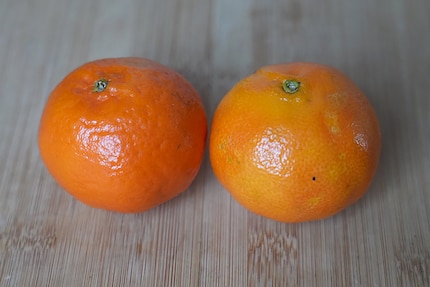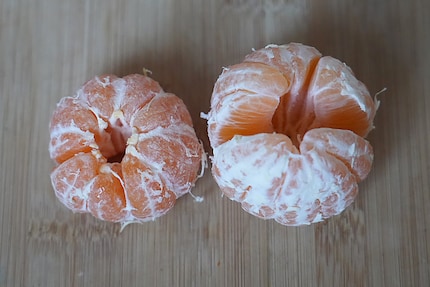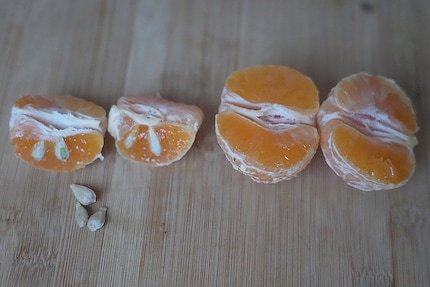
Background information
Juice with bits and five other fruity creations
by Simon Balissat

Mandarin season is finally here. Clementine too! Damn, what’s the difference again? This guide will help you keep them apart once and for all.
They accompany us through every winter, yet most people know very little about them. But as a mini survey in my private and professional environment reveals, most citrus enjoyers know very well whether they prefer mandarins or clementines. However, very few people know the difference between the two fruits. Turns out there are actually quite a few ways to tell them apart.
All clementines are mandarins, but not all mandarins are clementines. Or something along those lines. The long version: mandarins have been around for much longer, being cultivated in China for several thousand years. The clementine, on the other hand, is an offshoot of the mandarin and has only been around for a little over a hundred years. Really, it was all accidental. It was created by chance when a mandarin and a bitter orange were crossed. A monk called Frère Clément (ha, there’s the name!) discovered them in the garden of an orphanage in Algeria.
Today, you’ll find them piled up in the same fruit corner of the supermarket and you can hardly tell them apart visually. On closer inspection, however, you’ll notice that the skin of the mandarin is somewhat darker and more spherical than that of its daughter, the clementine. The difference becomes even clearer when peeling. A mandarin peel is thinner and is usually easier to remove. This is also down to mandarins being loose-skinned. If stored longer, a cavity forms between the peel and the flesh. Due to its thin shell, however, it’s also less protected and develops pressure marks more quickly. On supermarket shelves, they can often feel mushy as a result.

You can probably already guess which of the two citrus fruits has a longer shelf life. Yep. The peel of the clementine is thicker than that of the mandarin and there’s no air between the fruit and the skin, ergo it has a longer shelf life. If stored correctly – i.e. in the fridge or on a cool balcony – it can be enjoyed for up to two months. Mandarins only last about two weeks. Soft ones where you can feel a larger cavity between the skin and the fruit should therefore be left in the supermarket. It’s a classic sign that they’ve probably been there too long.
Ever actually counted the individual slices? Try it! You’ll see the mandarin always has exactly nine segments. Clementines, on the other hand, have between eight and twelve. The flesh of a mandarin is also a juicy orange, while clementines are somewhat lighter and more yellowy-orange. However, both have a high vitamin C content.

It’s common knowledge that mandarins have seeds and clementines don’t. False common knowledge, that is. Clementines sometimes do have seeds – but way fewer than their parent fruit. It’s probably why they’re usually much more popular with children. The number of seeds lurking inside the fruit also depends on which pollinating trees were nearby during the flowering period. A shame you can’t tell from the outside on supermarket shelves.

Another reason why children are much more likely to like clementines: they’re sweeter than their parent fruit thanks to their higher sugar content. Mandarins usually have a more intense and slightly sour taste.
Despite all their differences, Mother Mandarin and Daughter Clementine still have a lot in common. One of the most important similarities is their intense and unmistakeable Christmas scent. And now, you’re well equipped with all the knowledge needed to impress your friends at the next get-together.
Header image: Katja Fischer
Mom of Anna and Elsa, aperitif expert, group fitness fanatic, aspiring dancer and gossip lover. Often a multitasker and a person who wants it all, sometimes a chocolate chef and queen of the couch.
Interesting facts about products, behind-the-scenes looks at manufacturers and deep-dives on interesting people.
Show all